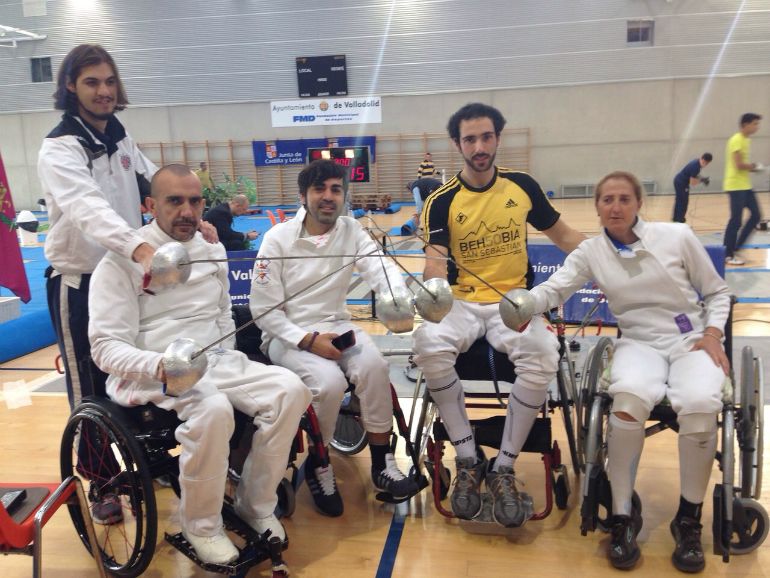Share:
Take it offline!
This Education in Motion resource is also available as a printable PDF.
Download PDF
Challenging and competitive, adapted fencing is a much-loved Paralympic sport, requiring precision, technique, and physical strength. Like traditional fencing, adapted fencing, which requires that athletes compete from their wheelchairs, is focussed on reflex and agility skills.
A Brief History
Wheelchair fencing began in England in 1954, when Sir Ludwig Guttman, a keen fencer, performed a demonstration against a paraplegic opponent from the Spinal Unit at Rockwood, Cardiff. Excited by the success of this adapted version of fencing, Guttman went on visit Stoke Mandeville Hospital, where soldiers who had been wounded in World War II were undergoing recovery and rehabilitation. Guttman set to work coaching paraplegic patients in the art of fencing and, in 1955, launched the International Stoke Mandeville Games, where sabre fencing would be a core event.
Introduced to Paralympic games in Rome in 1960 as one of the first Paralympic sports, adapted fencing has maintained its popularity, enabling male and female athletes with a wide range of physical disabilities to test their strengths and engage in the highly tactical sport of fencing.
How Does It Work?
Adapted fencing requires that athletes duel with their wheelchairs anchored into position on the ground. The length of the fencing area is decided prior to the beginning of the duel, based on the distance choice of the competitor with the least reach with an extended arm.
As with traditional fencing, competitors wear protective clothing covering the face, torso, legs and hands, and are connected to an electronic signal box that registers when contact is made by the opponent's sword.
While in traditional fencing, athletes are required to score 15 touches, in adapted fencing the first competitor to reach five is the winner. Wheelchairs must not be rigid and must be 53 centimetres in height, with a backrest of at least 15 centimetres in height, positioned at 90 degrees (with some exceptions). The armrest on the opposite side must measure at least 10 centimetres.
In order to ensure fairness, competitors who have difficulty grasping or controlling the sword may have it instead attached to their arm. As with traditional fencing, deliberate hurting of an opponent or the modification of a weapon is strictly prohibited.
Categories
Male and female athletes who use wheelchairs, are amputees, or have mild cerebral palsy are eligible to compete in adapted fencing. Simpler than many other Paralympic sports in terms of classification, there are just two classes. Class A defines athletes who have full trunk and hand movement; Class B defines fencers who have limitations in trunk balance.

Three Types of Fencing
Like traditional fencing, wheelchair fencing is broken up into three distinct types. They are variable in rules, equipment, protective clothing, and participation.
Foil fencers wear a metallic lame jacket and a lame bib on the face mask. They use a foil, a light weapon derived from the court sword, to target their opponent’s trunk. The fencer must earn the right of way in foil by being the first to attack their opponent, parrying or blocking their opponent’s attack, or taking their opponents blade. When the fencer has right of way, they are eligible to score points. This happens when the weapon’s point makes contact with the opponent’s jacket and the button at the end of the weapon is fully compressed.
Using the epee, a weapon derived from the traditional duelling sword, fencers in this discipline wear lame aprons covering the non-target area and aim for the whole body of their opponent from the waist upwards. There is no right of way; both fencers are eligible to score points during play. This occurs when the weapon’s point makes contact with the opponent’s target area and the button at the end of the weapon is fully depressed. Both fencers are eligible to score simultaneously.
A male-only category, sabre fencing uses a sabre, derived from the cavalry sword. Athletes, who wear a lame jacket, a lame bib on a metallic face mask, and a lame cuff, aim for their opponent’s trunk above the waist, arms and head. Both fencers are eligible to score points at any stage. This happens when some part of the weapon makes contact with the opponent’s metallic lame jacket or face mask. Because the sabre is a cutting weapon, the whole weapon is electrified. Sabre fencing is incredibly fast-paced.
Get Involved
Budding wheelchair fencers have plenty of options for becoming involved with the sport. Its ongoing popularity means that many universities have fencing clubs and teams, and training clubs are available at a variety of sporting outlets. Hopefuls should get in touch with the Australian Fencing Federation or the International Wheelchair and Amputee Sports Federation.
Fencing is a lot of fun and a great way to connect with other aspiring athletes. As one of the most precise, intricate sports on the Paralympic agenda, getting good requires serious commitment and dedication. Talented wheelchair fencers train for years to hone their skills and improve agility. Australia hasn’t won a medal for adapted fencing since 1964 when it earned a silver and a bronze, so there’s plenty of opportunities for new athletes to snatch success!
For an active lifestyle, check out our wide range of wheelchairs for your daily or sporting needs at www.sunrisemedical.com.au